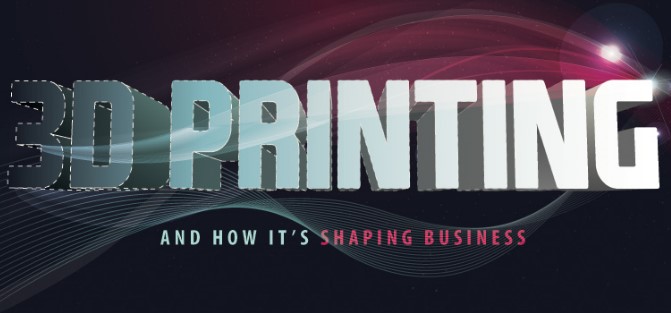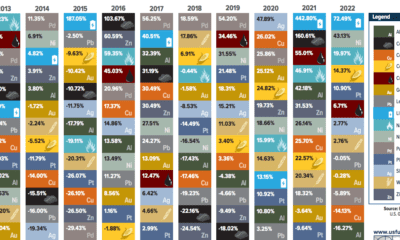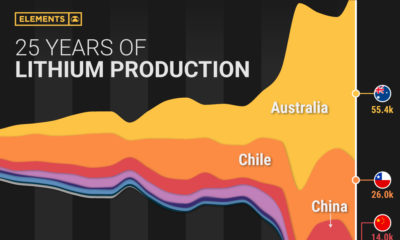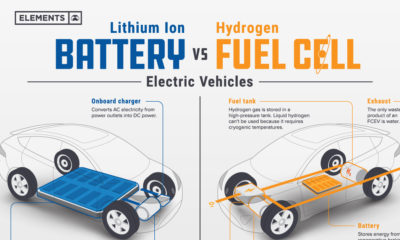Lithium: The Key Ingredient Powering Today’s Technology
Lithium infographic presented by: Dajin Resources Lithium is nature’s lightest metal, but it is also one of the most chemically reactive, which makes it a key ingredient in powering and building the latest technology. Most similar to a material such as wood in density, lithium would float on water if it didn’t react with it so intensely. The light metal even reacts with air almost instantly, turning from a silvery-white to dark grey. Why is lithium so reactive? It is because it has a single valence electron that it can lend to many different types of chemical reactions. Before 1990, it was rare for more than 100,000 tonnes of lithium to be used each year. However, since then demand has skyrocketed to closer to 600,000 tonnes per year, where it is today. Lithium’s uses are split between chemical and technical, but the fastest growing segments of demand are derived from its electrochemical potential. Lithium has the highest electric output per unit weight of any battery material, which makes it the obvious choice for energy storage in many types of technology. Electric cars, renewable energy, smart grids, and consumer electronics are all using lithium ion batteries, and these markets all show signs of growth in the future. Furthermore, lithium has some other interesting uses as well. Recently Alcoa developed a 4th generation aluminum-lithium alloy to reduce weight of airliners. The result is a 15% fuel savings through increased fuel efficiency. While lithium is not scarce, it does tend to be deposited in very low concentrations through many types of rocks. The biggest challenge is finding high enough concentrations to make it cost-efficient to produce. Uniquely to lithium, brine deposits can cut exploration and milling costs by up to 50%, which has priced many hard rock miners out of the market. Brine deposits are produced mainly from salt flats, which are also known as salars. The “Lithium Triangle” is the major industrial producer of lithium and holds over 70% of global reserves. The only producing lithium mine in the United States is in Clayton Valley, Nevada in the “Lithium Hub”, which is very close to the site of Tesla’s $5 billion Gigafactory. Lithium, because of its physical and chemical properties, is an essential ingredient powering today’s technology. Moving forward, lithium will be even more important for crucial areas such as power storage, electronics, automobiles, defense, and aerospace. Related infographic: The Look and Feel of Canadian Venture Market Bottoms from 1981-2014
on But fast forward to the end of last week, and SVB was shuttered by regulators after a panic-induced bank run. So, how exactly did this happen? We dig in below.
Road to a Bank Run
SVB and its customers generally thrived during the low interest rate era, but as rates rose, SVB found itself more exposed to risk than a typical bank. Even so, at the end of 2022, the bank’s balance sheet showed no cause for alarm.
As well, the bank was viewed positively in a number of places. Most Wall Street analyst ratings were overwhelmingly positive on the bank’s stock, and Forbes had just added the bank to its Financial All-Stars list. Outward signs of trouble emerged on Wednesday, March 8th, when SVB surprised investors with news that the bank needed to raise more than $2 billion to shore up its balance sheet. The reaction from prominent venture capitalists was not positive, with Coatue Management, Union Square Ventures, and Peter Thiel’s Founders Fund moving to limit exposure to the 40-year-old bank. The influence of these firms is believed to have added fuel to the fire, and a bank run ensued. Also influencing decision making was the fact that SVB had the highest percentage of uninsured domestic deposits of all big banks. These totaled nearly $152 billion, or about 97% of all deposits. By the end of the day, customers had tried to withdraw $42 billion in deposits.
What Triggered the SVB Collapse?
While the collapse of SVB took place over the course of 44 hours, its roots trace back to the early pandemic years. In 2021, U.S. venture capital-backed companies raised a record $330 billion—double the amount seen in 2020. At the time, interest rates were at rock-bottom levels to help buoy the economy. Matt Levine sums up the situation well: “When interest rates are low everywhere, a dollar in 20 years is about as good as a dollar today, so a startup whose business model is “we will lose money for a decade building artificial intelligence, and then rake in lots of money in the far future” sounds pretty good. When interest rates are higher, a dollar today is better than a dollar tomorrow, so investors want cash flows. When interest rates were low for a long time, and suddenly become high, all the money that was rushing to your customers is suddenly cut off.” Source: Pitchbook Why is this important? During this time, SVB received billions of dollars from these venture-backed clients. In one year alone, their deposits increased 100%. They took these funds and invested them in longer-term bonds. As a result, this created a dangerous trap as the company expected rates would remain low. During this time, SVB invested in bonds at the top of the market. As interest rates rose higher and bond prices declined, SVB started taking major losses on their long-term bond holdings.
Losses Fueling a Liquidity Crunch
When SVB reported its fourth quarter results in early 2023, Moody’s Investor Service, a credit rating agency took notice. In early March, it said that SVB was at high risk for a downgrade due to its significant unrealized losses. In response, SVB looked to sell $2 billion of its investments at a loss to help boost liquidity for its struggling balance sheet. Soon, more hedge funds and venture investors realized SVB could be on thin ice. Depositors withdrew funds in droves, spurring a liquidity squeeze and prompting California regulators and the FDIC to step in and shut down the bank.
What Happens Now?
While much of SVB’s activity was focused on the tech sector, the bank’s shocking collapse has rattled a financial sector that is already on edge.
The four biggest U.S. banks lost a combined $52 billion the day before the SVB collapse. On Friday, other banking stocks saw double-digit drops, including Signature Bank (-23%), First Republic (-15%), and Silvergate Capital (-11%).
Source: Morningstar Direct. *Represents March 9 data, trading halted on March 10.
When the dust settles, it’s hard to predict the ripple effects that will emerge from this dramatic event. For investors, the Secretary of the Treasury Janet Yellen announced confidence in the banking system remaining resilient, noting that regulators have the proper tools in response to the issue.
But others have seen trouble brewing as far back as 2020 (or earlier) when commercial banking assets were skyrocketing and banks were buying bonds when rates were low.
















